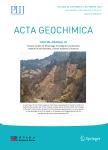Geological and geochemical characteristics of the Baogudi Carlintype gold district(Southwest Guizhou, China) and their geological implications
Geological and geochemical characteristics of the Baogudi Carlintype gold district(Southwest Guizhou, China) and their geological implications作者机构:State Key Laboratory of Ore Deposit GeochemistryInstitute of GeochemistryChinese Academy of SciencesGuiyang 550081China University of Chinese Academy of SciencesBeijing 100049China No.105 Geological TeamGuizhou Bureau of Geology and Mineral Exploration and DevelopmentGuiyang 550018China Bureau of Geology and Mineral Exploration and Development Guizhou ProvinceGuiyang 550004China Guizhou Education UniversityGuiyang 550018China School of PharmacyChengdu University of Traditional Chinese MedicineChengdu 611137China
出 版 物:《Acta Geochimica》 (地球化学学报(英文))
年 卷 期:2019年第38卷第4期
页 面:587-609页
核心收录:
学科分类:07[理学]
基 金:supported by the National Key R&D Program of Deeppenetrating Geochemistry (2016YFC0600607) Deep Mineral Resources Exploration and Exploitation (2017YFC0601500) the Geological Research Project of Bureau of Geology and Mineral Exploration and Development Guizhou Province (Qian Di Kuang Ke He (2017) No. 10) the National Science Foundation of China (Nos. 41802027, 41802088)
主 题:Elemental geochemistry Fluid inclusions Stable isotopes Carlin-type gold deposits Baogudi gold district Southwestern Guizhou
摘 要:The newly discovered Baogudi gold district is located in the southwestern Guizhou Province,China,where there are numerous Carlin-type gold *** better understand the geological and geochemical characteristics of the Baogudi gold district,we carried out petrographic observations,elemental analyses,and fluid inclusion and isotopic composition *** also compared the results with those of typical Carlin-type gold deposits in southwestern *** mineralization stages,namely,the sedimentation diagenesis,hydrothermal(main-ore and late-ore substages),and supergene stages,were identified based on field and petrographic *** main-ore and late-ore stages correspond to Au and Sb mineralization,respectively,which are similar to typical Carlin-type *** mass transfer associated with alteration and mineralization shows that a significant amount of Au,As,Sb,Hg,Tl,Mo,and S were added to mineralized rocks during the main-ore ***,arsenic,Sb,and S were added to the mineralized rocks during the late-ore *** migration indicates that the sulfidation process was responsible for ore *** types of fluid inclusions were identified in ore-related quartz and *** main-ore stage fluids are characterized by an H2O–NaCl–CO2–CH4±N2system,with medium to low temperatures(180–260℃)and low salinity(0–9.08%NaCl equivalent).The late-ore stage fluids featured H2O–NaCl±CO2±CH4,with low temperature(120–200℃)and low salinity(0–7.48%Na Cl equivalent).The temperature,salinity,and CO2and CH4concentrations of ore-forming fluids decreased from the main-ore stage to the late-ore *** calculated δ^13C,d D,and δ^18O values of the ore-forming fluids range from-14.3 to-7.0%,-76 to-55.7%,and 4.5–15.0%,***-ore-stage stibnite had δ^34S values ranging from-0.6 to 1.9%.These stable isotopic compositions indicate that the ore-forming fluids originated mainly from deep magmatic hydrothermal fluids,with minor contribution



